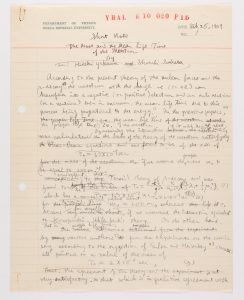Archive of historical materials

Draft: The Mass and the Mean Life Time of the Mesotron
OU1939-A1 (8 pages) Date: February 26, 1939
This manuscript was written during the early stage of the co-authoring of “The Mass and the Life-Time of the Mesotron” (Proc. Phys.-Math. Soc. Japan 21, 138-140 (SN) (1939)) by Yukawa and Shoichi Sakata. When this paper was written, it was not known whether the mesotron (presently known as charged pi-meson) introduced by Yukawa for the purpose of explaining the nuclear force was the same as or different from the particle (presently known as muon) discovered during the observation of cosmic rays in 1936. The mesotrons that mediate the nuclear force were believed to be unstable and disintegrate easily. Hypothesizing that mesotrons would break down into electrons and neutrinos by following the same process as the beta decay, Yukawa et. al. calculated the lifetime of the mesotron. The lifetime estimated based on the behavior of the particles observed in cosmic rays was more than 10 times longer than the lifetime calculated by Yukawa et. al. To explain this difference, Yukawa et. al. sought various possibilities. Presently, it is known that the pi-mesons are bosons with spin-zero and the muons are fermions with the spin of 1/2 (same as the spin of electrons). The mass of the pi-meson is slightly heavier but almost the same, and both particles break down into electrons and neutrinos with W bosons as a mediator. There are some differences between bosons and fermions. The lifetime of the charged pi-meson is about 1/100 of the lifetime of the muon. With the limited experimental and observation data available at that time, Yukawa et. al. strove fiercely to find out through the research exactly what those particles and the force (interaction) were. (Written by Yutaka Hosotani)


